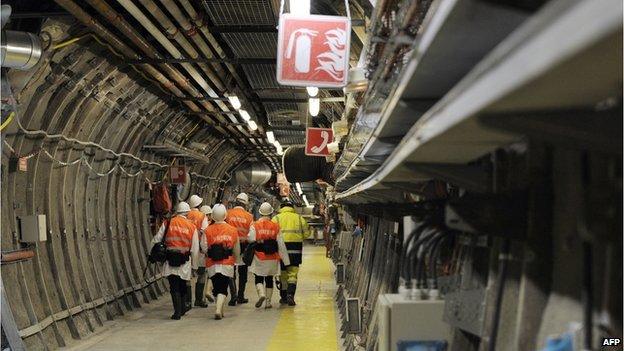How France is disposing of its nuclear waste
- Published

The underground lab at Bure could be the final resting place for most of France's highly radioactive waste
Half a kilometre below ground in the Champagne-Ardenne region of eastern France, near the village of Bure, a network of tunnels and galleries is being hacked out of the 160 million-year-old compacted clay rocks.
The dusty subterranean science laboratory built by the French nuclear waste agency Andra is designed to find out whether this could be the final resting place for most of France's highly radioactive waste, the deadly remains of more than half a century of nuclear energy.
Emerging from the industrial lift there are a series of passageways about the size of an underground rail tunnel.
The walls are reinforced with steel ribs and sprayed with grey concrete and there are huge bore holes drilled 100m into the rock walls which would hold the capsules of radioactive waste. If the scheme gets the final approval, the first waste could be inserted here in around 10 years.
France generates around three quarters of its electricity from nuclear power but despite decades of activity it is no nearer a solution to the perils of nuclear waste.
Many countries agree the hazardous material - some of it at temperatures of 90C - has to be disposed of deep below ground where it can be isolated from all living things for tens of thousands of years whilst the radiation slowly reduces.
Despite advanced schemes in Finland, not a single country worldwide has an operational underground repository.
"What we did first was to demonstrate that safety can be achieved through a repository in this clay formation," says Gerald Ouzounian, the head of international affairs for Andra, told Costing the Earth on BBC Radio 4.
Technical test
Since 2006, they have been developing experiments to prove they can do it technically. Equipment has been set up to simulate the heat the waste will generate and to monitor the impact on the clay.
"There are still risks of water ingress especially from the shafts and the top," says Mr Ouzounian, so they are testing ways to seal the waste using a bentonite clay plug.
French law requires companies to build a retrievable scheme, meaning that for the first few hundred years at least, they can remove the waste again should future generations find a better way to get rid of it.
But it is above ground that the real battle is taking place.
Repository plans have foundered in Britain and America due to local democratic opposition.
Britain copied the Scandinavian model based on voluntarism which allowed local communities to opt in but also built confidence by giving them a right to say no.
The British scheme was set to explore an underground laboratory in Cumbria near the Sellafield nuclear site. The local district council approved the scheme but the strategic authority - the council in Carlisle - blocked it in January 2013, sending the nuclear planners back to the drawing board.
A UK Government white paper to be published in the summer is widely expected to tweak the approval process to curb a county council's influence. The hunt is now on for a new location.
In France, the cash was the answer. They are already spending £50m ($80m / 60m euros) every year to support local community projects and massage consent in what is a sparsely populated and neglected area.
They even arranged the underground laboratory to ensure its two entrances were in different communities so they could pay them both off and ensure wider approval.
"I supported the laboratory from the start and I won't go back on that now," says the local mayor Francois Henri. But he admits that if his community had wanted to block the project there would be little they could do to stop it.
"It is a project which is of national interest. Nobody has the power to stop or to block it," says Gerald Ouzounian.
Resistance movement
He says the nation as a whole has benefited from nuclear power and all the stakeholders will help the government make the final decision.
Local resistance is muted and comes mainly from the pressure group "Bure Zone Libre". Its members who gave me their view but not their names said it had been largely ignored.
"The voice of the people is nothing, they make public debates after decisions," one protestor tells me.
"First stop nuclear energy and after we can talk about the waste."
French law required a national consultation or debate on the waste dump to take place but it was troubled from the start; meetings were disrupted forcing it to conduct its deliberations online.
When the debate finally concluded recently, it recommended slowing down the repository scheme to allow for more scientific tests.
"Having a six-month debate on a project that will last 100,000 years sounds a bit ridiculous," says Ariane Metais, one of a team of facilitators who run the engagement process around the policy.
"For a project with such environmental and ethical consequences, 'it is just not enough'."
If Britain were to copy the French and opt for a deep repository in clay for the vast quantities of UK waste it wouldn't be hard to find, chuckles Gerald Ouzounian.
"You have a lot of suitable (rock) formations in the south east of England," he says.
"The name of the clay is Callovo-Oxfordian which comes from Oxford."
As to whether it would be easy politically to sell a nuclear dump to the citizens of Oxford, he says, is another matter.